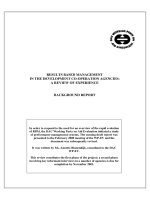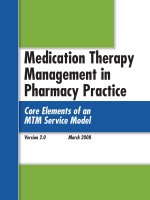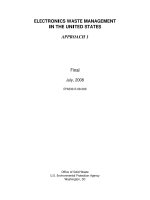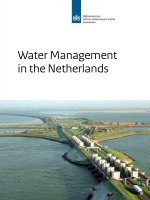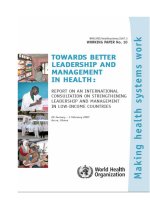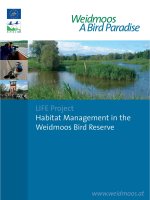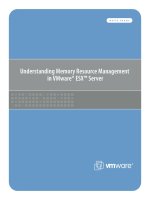Organizational flexibility management in construction
Bạn đang xem bản rút gọn của tài liệu. Xem và tải ngay bản đầy đủ của tài liệu tại đây (5.06 MB, 554 trang )
ORGANIZATIONAL FLEXIBILITY MANAGEMENT
IN
CONSTRUCTION
LIM TECK HENG, BENSON
(BACHELOR OF BUILDING CONSTRUCTION MANAGEMENT, HONOURS), UNSW
A THESIS SUBMITTED
FOR
THE DEGREE OF DOCTOR OF PHILOSOPHY
DEPARTMENT
OF BUILDING
NATIONAL
UNIVERSITY OF SINGAPORE
2010
i
ACKNOWLEDGMENTS
I would like to express my thanks and gratitude to the following people for their time,
help, guidance, encouragement and support in the production of this doctoral thesis.
I am indebted to the Singapore participants for their time and comments on the
various aspects of this research. This research would not have been possible without
their participation.
From the bottom of my heart, I thank Associate Professor Florence Ling Yean Yng,
my thesis supervisor, for her steadfast encouragement, motherly advice and
incredible patience on all occasions during my three-year PhD candidature. This
thesis would certainly not exist without her inspiration and support. Also, special
thanks must go to Professor George Ofori and Dr. Benny Raphael, my thesis
committee members, for their time and advices on my research.
Likewise, I am truly grateful to Dr Hing-Po Lo of the Department of Management
Sciences at the City University of Hong Kong for his guidance and prompt responses
to my queries concerning the application of multivariate statistical techniques. My
thanks also go to Professor Peter Lansley of the University of Reading for his
valuable suggestions on my research.
The scholarship award and financial support, from the National University of
Singapore (NUS) and Berkeley-NUS Risk Management Institute (RMI), for this study
are gratefully acknowledged. Thanks also go to all my friends and colleagues at the
National University of Singapore, especially Shamas-Ur-Rehman Toor, Jovan
Pantelic, Lu-Chang Peh, Allan Lee and Boon-Kuang Oh for their friendship and
encouragement throughout my study.
Finally, I thank my lovely wife, Dr. Bee-Lan Oo, who has been subjected to countless
annoyance by myself over the last three years of study period, all of which she has
endured both graciously and positively. Bee, this thesis is dedicated to you and our
Barrie. Also, I am eternally grateful to my family for their relentless support and
encouragement throughout this study, especially my mummy (Mdm. Mona Mah) and
daddy (Mr. Ricky Lim).
ii
TABLE OF CONTENTS
Page
ACKNOWLEDGMENTS i
TABLE OF CONTENTS ii
SUMMARY ix
LIST OF TABLES xi
LIST OF FIGURES xviii
CHAPTER 1
INTRODUCTION
1.1 Background 1
1.2 Research problem 2
1.3 Knowledge gap 5
1.4 Research aim and objectives 6
1.5 Definition of terms 7
1.6 Research hypotheses 8
1.7 Scope of research 10
1.8 Research method 11
1.9 Research significance 12
1.9.1 Theoretical significance 12
1.9.2 Practical significance 14
1.9.3 Methodological significance 14
1.10 Structure of the thesis 15
CHAPTER 2
THE BUSINESS ENVIRONMENT OF CONSTRUCTION FIRMS
2.1 Introduction 18
2.2 Nature of the construction industry 18
2.3 Construction firms and their business environment 20
2.3.1 Construction firms 20
2.3.2 Business environment 22
2.4 Changes in the business environment of construction firms 26
2.4.1 Construction demand 26
2.4.2 Intensity of competition 30
2.4.3 Procurement trend 33
2.4.4 Clients’ performance criteria of construction services 36
2.4.5 Technological need 38
2.5 Changes in the Singapore construction industry 41
2.6 Need for organizational flexibility 51
iii
2.6.1 Flexibility management in construction 52
2.6.1.1 Flexibility within corporate-level management 52
2.6.1.2 Flexibility within project-level management 54
2.6.2 Flexibility as a challenge in construction 56
2.7 Summary 58
CHAPTER 3
THEORETICAL FRAMEWORK OF FLEXIBILITY MANAGEMENT
3.1 Introduction 60
3.2 Concept of flexibility 60
3.3 Definitions of flexibility 63
3.4 Formulating the definition of organizational flexibility 68
3.5 Other defining features of flexibility 70
3.5.1 Hedging 71
3.5.2 Organizational slack 71
3.5.3 Liquidity 72
3.5.4 Versatility and agility 73
3.5.5 Strategic renewal 73
3.6 Multi-dimensional perspective of organizational flexibility 74
3.6.1 Dimensionality of flexibility 75
3.6.1.1 Micro-perspective of flexibility 75
3.6.1.2 Macro perspective of flexibility 76
3.6.1.3 Flexibility dimensions 79
3.6.2 Types of flexibility 81
3.7 Key determinants of organizational flexibility 89
3.8 Conceptual framework for organizational flexibility 92
3.9 Theories to underpin the conceptual framework 94
3.9.1 Contingency theories 94
3.9.2 Organizational learning theory 100
3.9.3 Resource-based theories 105
3.9.3.1 Resources 107
3.9.3.2 Capabilities 108
3.9.4 Complexity theory 112
3.10 Integration of four theories into the proposed conceptual framework 116
3.11 Summary 118
CHAPTER 4
DETERMINANTS OF ORGANIZATIONAL FLEXIBILITY
4.1 Introduction 121
4.2 Organizational learning culture (X1) 121
4.2.1 Definition 122
4.2.2 Possible dimensions 123
4.2.2.1 Commitment to learning 124
4.2.2.2 Shared vision 124
4.2.2.3 Open-mindedness 125
4.2.2.4 Intra-organizational knowledge sharing 126
4.2.3 Domain 127
4.2.3.1 Organizational learning culture (X1) and organizational structure (X2) 127
iv
4.2.3.2 Organizational learning culture (X1) and employees’ skills and behaviour (X3)
128
4.2.3.3 Organizational learning culture (X1) and technological capabilities (X4) 129
4.2.3.4 Organizational learning culture (X1) and business strategies (X6) 130
4.2.4 Measurement items 132
4.3 Organizational structure (X2) 134
4.3.1 Definition 134
4.3.2 Possible dimensions 136
4.3.2.1 Complexity 136
4.3.2.2 Integration 137
4.3.2.3 Formalization 138
4.3.2.4 Centralization 138
4.3.3. Design of organizational structure 139
4.3.3.1 Simple configuration 140
4.3.3.2 Functional configuration 140
4.3.3.3 Divisional configuration 141
4.3.3.4 Matrix configuration 141
4.3.3.5 Mechanistic versus Organic structures 142
4.3.4 Domain 143
4.3.4.1 Organizational structure (X2) and business strategies (X6) 143
4.3.4.2 Organizational structure (X2) and organizational flexibility (Y) 144
4.3.5 Measurement items 145
4.4 Employees’ skills and behaviour (X3) 147
4.4.1 Domain 147
4.4.1.1 Employees’ skills and behaviour (X3) and technological capabilities (X4) 148
4.4.1.2 Employees’ skills and behaviour (X3) and supply chain capabilities (X5) 149
4.4.1.3 Employees’ skills and behaviour (X3) and business strategies (X6) 149
4.4.1.4 Employees’ skills and behaviour (X3) and organizational flexibility (Y) 150
4.4.2 Human resource management practices 152
4.4.3 Measurement items 153
4.5 Technological capabilities (X4) 155
4.5.1 Definition 155
4.5.2 Possible dimensions 157
4.5.2.1 Information technology capabilities 158
4.5.2.2 Process technology capabilities 158
4.5.3 Domain 159
4.5.3.1 Technological capabilities (X4) and organizational structure (X2) 159
4.5.3.2 Technological capabilities (X4) and supply chain capabilities (X5) 160
4.5.3.3 Technological capabilities (X4) and business strategies (X6) 162
4.5.3.4 Technological capabilities (X4) and organizational flexibility (Y) 163
4.5.4 Measurement items 164
4.6 Supply chain capabilities (X5) 166
4.6.1 Definition 166
4.6.2 Inter-organizational relationship management practices 169
4.6.3 Domain 170
4.6.3.1 Supply chain capabilities (X5) and business strategies (X6) 171
4.6.3.2 Supply chain capabilities (X5) and organizational flexibility (Y) 172
4.6.4 Measurement items 173
4.7 Business strategies (X6) 175
4.7.1 Definition 175
4.7.1.1 Perspectives of strategy 175
4.7.1.2 Aspects of strategy 176
4.7.2 Business strategy models 177
4.7.2.1 Miles and Snow’s (1978) generic typology 178
4.7.2.2 Porter’s (1980) generic typology 180
4.7.2.3 Treacy and Wiersema’s (1993) value disciplines model 182
4.7.3 Possible dimensions 183
4.7.4 Business strategies (X6) and organizational flexibility (Y) 184
v
4.7.5 Measurement items 187
4.8 The role of environments on firms’ resources and capabilities, and flexibility 189
4.8.1 Possible dimensions 190
4.8.2 Measurement items 192
4.9 Summary 194
CHAPTER 5
RESEARCH DESIGN AND DATA COLLECTION METHODS
5.1 Introduction 196
5.2 Survey research design 196
5.3 Exploratory phase 199
5.3.1 Face-to-face interview approach 199
5.3.2 Development of interview guide question 201
5.3.3 Preliminary interview findings 203
5.3.3.1 Business environment in the Singapore construction industry 204
5.3.3.2 Industry practitioners’ perspectives on organizational flexibility 205
5.3.3.3 Types of flexibility 206
5.4 Questionnaire development phase 207
5.4.1 Specify domain of constructs 209
5.4.2 Generation of sample of measurement items 210
5.4.3 Questionnaire design 211
5.4.4 Pilot study 213
5.4.5 Organization of the questionnaire 214
5.4.5.1 Part 2: Human resource 214
5.4.5.2 Part 3: Organizational culture 215
5.4.5.3 Part 4: Organizational structure 215
5.4.5.4 Part 5: Organizational supply chain 216
5.4.5.5 Part 6: Business practices 216
5.4.5.6 Part 7: Information technology 216
5.4.5.7 Part 8: Process technology 217
5.4.5.8 Part 9: Environmental condition 217
5.4.5.9 Part 10: Organizational flexibility 217
5.5 Data collection and analysis phase 217
5.5.1 Data collection process 218
5.5.2 Face-to-face interview approach 219
5.5.3 Stratified sampling method 220
5.5.4 Sampling frame and selection process 221
5.5.5 Key informant retrospective reporting approach 222
5.6 Validation process for statistical results 225
5.7 Summary 226
CHAPTER 6
METHODS OF ANALYSIS
6.1 Introduction 227
6.2 Review of statistical modelling techniques and structural equation modelling 227
6.2.1 First generation analysis techniques 227
6.2.2 Second generation analysis techniques - SEM 230
6.3 Types of SEM approach 234
6.3.1 Comparison between covariance-based SEM and component-based SEM 235
vi
6.3.2 Justification for using PLS approach 237
6.4 The PLS modelling process 239
6.4.1 Preparation of sample data 241
6.4.1.1 Common method variance 241
6.4.1.2 Multicollinearity 242
6.4.2 The PLS model specification 243
6.4.3 PLS modelling approach and its parameter estimation process 251
6.4.3.1 Confirmatory factor analysis 255
6.4.3.2 Path analysis 257
6.4.3.3 Bootstrapping technique 259
6.4.4 Construct validation process 261
6.4.4.1 Internal reliability 264
6.4.4.2 Uni-dimensionality 266
6.4.4.3 Convergent and discriminant validities 269
6.4.4.4 Removal of inconsistent measurement items 271
6.4.5 Evaluating structural models in PLS 272
6.5 Moderator analysis approach 273
6.5.1 General problems in moderator analysis 274
6.5.2 Justification for using the PLS product-indicator approach 276
6.5.3 Procedure of the PLS product-indicator approach 277
6.6 Summary 279
CHAPTER 7
MEASUREMENT MODELS
7.1 Introduction 280
7.2 Sample profile and response rate 280
7.3 Results of classical validation approach 283
7.3.1 Cronbach’s alpha and item-to-total correlation 288
7.3.2 Exploratory factor analysis (EFA) 289
7.3.2.1 Factor analysis of organizational learning culture (X1) 290
7.3.2.2 Factor analysis of business strategies (X6) 292
7.3.2.3 Factor analysis of environmental conditions (Z) 296
7.3.2.4 Factor analysis of organizational flexibility (Y) 299
7.3.2.5 Factor analysis of single-dimensional constructs 302
7.4 Results of contemporary validation approach 306
7.4.1 Composite reliability 315
7.4.2 Standardized factor loadings and average variance extracted (AVE) 315
7.4.3 Square root of AVE and cross loading analysis 316
7.5 Standard deviation of measurement items of individual constructs 318
7.6 Hypothesis testing of H1 326
7.7 Summary 326
CHAPTER 8
STRUCTURAL MODELS AND HYPOTHESES TESTING
8.1 Introduction 328
8.2 Evaluation of structural model of PLS M1 328
8.2.1 Model trimming process 329
8.2.2 Overall F-test for R
2
334
8.2.3 Assessment of path coefficients 334
vii
8.3 Interpretation and discussion of findings of PLSM1 336
8.3.1 Direct positive impact on operational flexibility (Y
OF
) 337
8.3.1.1 Employees’ skills and behaviour (X3) 337
8.3.1.2 Open-mindedness (X1
O
) 340
8.3.1.3 Supply chain capabilities (X5) 342
8.3.1.4 Cost leadership initiative (X6.1
CLS
) 343
8.3.2 Direct negative impact on operational flexibility (Y
OF
) 344
8.3.3 Direct impact on tactical flexibility (Y
TF
) 345
8.3.3.1 Supply chain capabilities (X5) 345
8.3.3.2 Product leadership (X6.2
PLS
) 348
8.3.4 Direct impact on strategic flexibility (Y
SF
) 349
8.3.4.1 Customer intimacy initiative (X6.2
CIS
) 350
8.3.4.2 Shared vision and value (X1
SV
) 351
8.3.4.3 Cost leadership initiative (X6.1
CLS
) 353
8.3.4.4 Risk leadership initiative (X6.1
RLS
) 355
8.4 Evaluation of structural model of PLS M2 358
8.4.1 Model trimming process 358
8.4.2 Overall F-test for R
2
361
8.4.3 Assessment of path coefficients and proposition testing 367
8.5 Interpretation and discussion of findings 370
8.5.1 Predictors of organizational structure (X2) 370
8.5.1.1 Open-mindedness (X1
O
) 370
8.5.1.2 Technological capabilities (X4) 373
8.5.2 Predictors of employees’ skills and behaviour 376
8.5.2.1 Competence development (C) 378
8.5.2.2 Stress management (SM) 380
8.5.2.3 Performance management (PM) 381
8.5.2.4 Intra-organizational relationship management (RM) 383
8.5.3 Predictors of technological capabilities (X4) 385
8.5.4 Predictors of supply chain capabilities (X5) 388
8.5.5 Predictors of business strategies (X6) 393
8.5.5.1 Impact on cost leadership initiative (X6.1
CLS
) 393
8.5.5.2 Impact on risk leadership initiative (X6.1
RLS
) 395
8.5.5.3 Impact on customer intimacy initiative (X6.2
CIS
) 398
8.5.5.4 Impact on product leadership initiative (X6.2
PIS
) 401
8.5.6 Predictors of organizational flexibility (Y) 403
8.5.6.1 Impact on operational flexibility (Y
OF
) 403
8.5.6.2 Impact on tactical flexibility (Y
TF
) 404
8.5.6.3 Impact on strategic flexibility (Y
SF
) 404
8.6 Moderating effects of environmental conditions (Z) 408
8.6.1 Moderating effects of environmental conditions on the relationship between
significant determinants and firms’ operational flexibility 409
8.6.2 Moderating effects of environmental conditions on the relationship between supply
chain capabilities and firms’ tactical flexibility 412
8.6.3 Moderating effects of environmental conditions on the relationship between
business strategies and firms’ strategic flexibility 414
8.7 Summary 418
CHAPTER 9
VALIDATION OF RESULTS AND PRACTICAL APPLICATION
9.1 Introduction 421
9.2 Designing flexibility indices 421
9.2.1 Operational flexibility (Y
OF
) 421
9.2.2 Tactical flexibility (Y
TF
) 422
viii
9.2.3 Strategic flexibility (Y
SF
) 423
9.3 Testing flexibility indices 424
9.3.1 Subject matter experts 424
9.3.2 Comparing actual and predicted indices 425
9.3.3 Correlations between organizational flexibility and annual turnover 429
9.4 Experts’ views about the resultant structural models 431
9.4.1 Experts’ opinions about the result of the PLS M1 431
9.4.1.1 Three dimensions of organizational flexibility within the model 431
9.4.1.2 Practicality and comprehensiveness of the results concering PLS M1 434
9.4.2 Experts’ opinions about the result of the PLS M2 434
9.5 Application 435
9.6 Summary 444
CHAPTER 10
SUMMARY AND CONCLUSIONS
10.1 Summary 450
10.2 Summary of research findings and validations of hypotheses 451
10.2.1 Conceptual framework for organizational flexibility 451
10.2.2 Key determinants of organizational flexibility 452
10.2.3 Inter-relationships of determinants 455
10.2.4 Moderating roles of market and technological conditions 461
10.2.5 Flexibility indices 462
10.3 Contribution to theory 463
10.4 Implications for practice 465
10.5 Limitations of the study 471
10.6 Conclusions 474
10.7 Directions of future research 475
Bibliography 478
Appendix A – Interview guide questions 514
Appendix B – List of proposed flexibility types and their definitions 516
Appendix C – Interview survey structured questionnaire 517
Appendix D – Example of invitation letter 527
Appendix E – Model validation instrument 528
ix
SUMMARY
The concept of organizational flexibility is explored in the context of the construction
industry by integrating four predominant perspectives of organizational studies.
These are: (1) the complex adaptive system perspective; (2) the organizational
learning perspective; (3) the resource-based view of firms; and (4) the dynamic
contingency view of firms. The developed theoretical framework postulates that firms
should manage their flexibility potential, by engaging into a continuous process of
developing and managing their resources and capabilities, for their continued
existence.
The aim of this thesis is to investigate the organizational flexibility management of
construction firms in Singapore. Organizational flexibility is hypothesized as a multi-
rather than single-dimensional concept. It may be influenced, to varying degrees, by
six key determinants (i.e., factors): (1) organizational learning culture; (2)
organizational structure; (3) employees’ skills and behaviour; (4) technological
capabilities; (5) supply chain capabilities; and (6) business strategies. The research
method is based on survey. The data collection instrument is a structured
questionnaire specially designed for this study. Data were collected using a face-to-
face interview approach involving 41 senior executives of large and medium-sized
construction firms in Singapore.
Based on the data collected, two structural equation models were developed to: (i)
identify the key dimensions and determinants of organizational flexibility, and (ii)
examine the effects of inter-relationships among the determinants on the three
dimensions of organizational flexibility. The results support the view that
organizational flexibility is a multi-dimensional concept, comprising: (1) operational
flexibility; (2) tactical flexibility; and (3) strategic flexibility, where individual
x
dimensions have their own configuration of determinants. Of the six determinants,
employees’ skills and behaviour, supply chain capabilities and business strategies
are found to have highest positive impacts on firms’ operational flexibility, tactical
flexibility and strategic flexibility, respectively. Also, it is found that supply chain
capability is the only determinant that has statistically significant impacts on two
dimensions of organizational flexibility, i.e., operational and tactical flexibilities.
Three sets of structural models were also developed to examine the moderating
effects of market and technological conditions on the relationships between the three
flexibility dimensions and their respective determinants. No moderating effect was
detected in the results. However, market and technological conditions are found to
have statistically significant direct impacts on firms’ operational and strategic
flexibilities, respectively.
It is concluded that construction firms need to develop the right kind and range of
resources and capabilities to achieve the desired level of flexibility. It is
recommended that construction firms use the flexibility indices developed by this
study to ascertain their flexibility potential. The findings may also help contractors to
attain organizational flexibility and offer managers an insight into different practices
and organizational attributes in building up their firms’ flexibility potential.
xi
LIST OF TABLES
Page
Table 3.1 Definitions of flexibility 64
Table 3.2 Flexibility dimensions 80
Table 3.3 Definitions of flexibility types 85
Table 3.4 Streamlining and contextualization of flexibility types 89
Table 3.5 Determinants of organizational flexibility 91
Table 4.1 Measurements items for organizational learning culture (X1) 132
Table 4.2 Measurement items for organizational structure (X2) 146
Table 4.3 Human resource management practices 152
Table 4.4 Measurement items for employees’ skills and behaviour (X3) 154
Table 4.5 Measurement items for technological capabilities (X4) 165
Table 4.6 Inter-organizational relationship management practices 170
Table 4.7 Measurement items for supply chain capabilities (X5) 174
Table 4.8 Measurement items for business strategies (X6) 187
Table 4.9 Measurement items for environmental conditions (Z) 193
Table 6.1 Types of dependence statistical methods 228
Table 6.2 Comparison of component-based and covariance-based SEM approaches
235
Table 6.3 Inner relations (structural relationships) among constructs for PLS M1 246
xii
Table 6.4 Outer relations and weight relations between constructs and their
corresponding observed variables for PLS M1 246
Table 6.5 Inner relations (structural relationships) among constructs for PLS M2 249
Table 6.6 Outer relations and weight relations between constructs and their
corresponding observed variables for PLS M2 249
Table 6.7 Rules on removal of inconsistent measurement items 271
Table 7.1 General information of interviewees’ firms 281
Table 7.2 Characteristics of the interviewees 282
Table 7.3 Categorization of constructs 283
Table 7.4 Results of classical validation approach 284
Table 7.5 Total variance explained for organizational learning culture 291
Table 7.6 Factor matrix for measurement items of organizational learning culture 292
Table 7.7 Total variance explained for business strategies 294
Table 7.8 Factor matrix for measurement items of business strategies 295
Table 7.9 Total variance explained for environmental conditions 298
Table 7.10 Factor matrix for measurement items of environmental conditions 298
Table 7.11 Total variance explained for organizational flexibility 301
Table 7.12 Factor matrix for measurement items of organizational flexibility 302
Table 7.13 Total variance explained for single-dimensional constructs 305
Table 7.14 Rotated component matrix for all single-dimensional construct 306
xiii
Table 7.15 Revised categorization of constructs 307
Table 7.16 Results of confirmatory factor analysis for PLS M1 308
Table 7.17 Results of confirmatory factor analysis for PLS M2 312
Table 7.18 Descriptive statistics, correlation matrix and the square roots of AVE for
PLS M1 and M2 317
Table 7.19 Standard deviation of measurement items 319
Table 7.20 Cross-loadings for individual measurement items of respective factors for
PLS M1 320
Table 7.21 Cross-loadings for individual measurement items of respective factors for
PLS M2 323
Table 8.1 Results of structural model of PLS M1 before and after the model trimming
process 332
Table 8.2 Results of the overall F-test for R
2
in PLS M1 334
Table 8.3 Results for the trimmed PLS M1 335
Table 8.4 Correlations between employees’ skills and behaviour and firms’
operational flexibility 338
Table 8.5 Correlations between firms’ open-mindedness and their operational
flexibility 341
Table 8.6 Correlations between firms’ supply chain capabilities and their operational
flexibility 342
Table 8.7 Correlations between firms’ cost leadership initiative and their operational
flexibility 343
Table 8.8 Correlations among firms’ shared vision and vision, organizational structure
and their operational flexibility 347
xiv
Table 8.9 Correlations between firms’ supply chain capabilities and their tactical
flexibility 348
Table 8.10 Correlations between firms’ product leadership initiative and their tactical
flexibility 349
Table 8.11 Correlations between firms’ customer intimacy initiative and their strategic
flexibility 351
Table 8.12 Correlations between firms’ shared vision and value and their strategic
flexibility 353
Table 8.13 Correlations between firms’ cost leadership initiative and their strategic
flexibility 354
Table 8.14 Correlations between firms’ risk leadership initiative and their strategic
flexibility 355
Table 8.15 Results of the overall F-test for R
2
in PLS M2 361
Table 8.16 Results of structural model of PLS M2 before and after the model
trimming process 362
Table 8.17 Hypotheses testing in the trimmed PLS M2 367
Table 8.18 Correlations between firms’ open-mindedness and their organizational
structure 371
Table 8.19 Organizational planning approach and leadership style of interviewees’
firms 372
Table 8.20 Hierarchical levels and structural configurations of interviewees’ firms 373
Table 8.21 Correlations between firms’ technological capabilities and their
organizational structure 374
Table 8.22 Correlations between firms’ commitment to learning and their employees’
skills and behaviour 377
Table 8.23 Correlations between firms’ competence development and their
employees’ skills and behaviour 379
xv
Table 8.24 Correlations between firms’ stress management practices and their
employees’ skills and behaviour 380
Table 8.25 Correlations between firms’ performance management and employees’
skills and behaviour 382
Table 8.26 Correlations between employees’ skills and behaviour and firms’ intra-
organizational relation management 383
Table 8.27 Correlations between firms’ shared vision and value and their
technological capabilities 387
Table 8.28 Number of technological-related training sessions provided by
interviewees’ firms 388
Table 8.29 Correlations between firms’ supply chain capabilities and their employees’
skills and behaviour 389
Table 8.30 Correlations between firms’ inter-organizational relationship management
practices and their supply chain capabilities 390
Table 8.31 Responsiveness of subcontractors and suppliers to requests made by
interviewees’ firms 393
Table 8.32 Correlations between firms’ supply chain capabilities and their cost
leadership initiative 394
Table 8.33 Correlations between firms’ commitment to learning and their cost
leadership initiative 395
Table 8.34 Correlations between firms’ supply chain capabilities and their risk
leadership initiative 396
Table 8.35 Correlations between firms’ organizational structure and their risk
leadership initiative 397
Table 8.36 Correlations between firm’s technological capabilities and their customer
intimacy initiative 399
xvi
Table 8.37 Correlations between firms’ employees’ skills and behaviour and their
customer intimacy initiative 400
Table 8.38 Correlations between firms’ open-mindedness and their product
leadership initiative 401
Table 8.39 Correlations between firms’ commitment to learning and their product
leadership initiative 402
Table 8.40 Path analysis on moderating effects of environmental conditions on
operational flexibility 410
Table 8.41 Correlations between firms’ operational flexibility and market conditions
411
Table 8.42 Path analysis on the moderating effects of environmental conditions on
tactical flexibility 414
Table 8.43 Path analysis on moderating effects of environmental conditions on
strategic flexibility 415
Table 8.44 Correlations between a firm’s strategic flexibility and technological
conditions 417
Table 9.1 Weights for individual measurement items of respective constructs 426
Table 9.2 Comparison of actual and normalized predicted indices 429
Table 9.3 Correlations between three flexibility dimensions and annual turnover 431
Table 9.4 Relationship guide 1 for checklists 442
Table 9.5 Relationship guide 2 for checklists 443
Table 9.6 Relationship guide 3 for checklists 445
Table 9.7 Relationship guide 4 for checklists 446
Table 9.8 Relationship guide 5 for checklists 447
xvii
Table 9.9 Relationship guide 6 for checklists 448
Table 10.1 Recommendations for developing employees’ skills and behaviour 468
Table 10.2 Recommendations for cost-related practices 469
xviii
LIST OF FIGURES
Page
Figure 2.1 Number of construction firm cessation 25
Figure 2.2 Value of contracts awarded in the Singapore construction industry 43
Figure 2.3 Market prices of construction material 44
Figure 3.1 Four-stage process for developing a generic taxonomy for assessing
firms’ flexibility 83
Figure 3.2 Conceptual framework for organizational flexibility 93
Figure 3.3 Hypothetical example of how contractors behave and react in the face of
marketplace influences 118
Figure 4.1 Classification of structural configurations concerning the potential for
flexibility 139
Figure 4.2 Groupings of various strategies into possible dimensions 178
Figure 5.1 The three-phase research process 198
Figure 6.1 Comparison between structural equation and multiple regression models
232
Figure 6.2 The PLS modelling process 240
Figure 6.3 PLS M1 constructed to test significance of determinants of organizational
flexibility 245
Figure 6.4 PLS M2 constructed to investigate interactions of determinants in
influencing organizational flexibility 248
Figure 6.5 A PLS model with two blocks of reflective observed variables 252
Figure 6.6 (a) Stage 1 estimation algorithm of PLS with description 254
xix
Figure 6.6 (b) Stage 1 estimation algorithm of PLS with equations 255
Figure 6.7 Path diagram of a single construct 256
Figure 6.8 Construct validation process 262
Figure 6.9 Methods of construct validation 263
Figure 6.10 A moderated model with predictor, moderator and predicted variables 277
Figure 7.1 Scree plot for organizational learning culture 291
Figure 7.2 Scree plot for business strategies 294
Figure 7.3 Scree plot for environmental conditions 298
Figure 7.4 Scree plot for organizational flexibility 301
Figure 7.5 Scree plot for single-dimensional constructs 305
Figure 8.1 The original PLS M1 329
Figure 8.2 The trimmed PLS M1 331
Figure 8.3 Statistically significant paths in the trimmed PLS M1 336
Figure 8.4 The original PLS M2 359
Figure 8.5 The trimmed PLS M2 366
Figure 8.6 Significant paths within the trimmed PLS M2 369
Figure 8.7 Level of subcontracting of interviewees’ firms 392
Figure 8.8 Moderating effects of environmental conditions on operational flexibility
410
xx
Figure 8.9 Moderating effects of environmental conditions on tactical flexibility 413
Figure 8.10 Moderating effects of environmental conditions on strategic flexibility 415
Figure 9.1 Checklist for attainment of operational flexibility 438
Figure 9.2 Checklist for attainment of tactical flexibility 439
Figure 9.3 Checklist for attainment of strategic flexibility 441
1
CHAPTER 1
INTRODUCTION
1.1 Background
The complex and dynamic environment, signifying uncertainty in decision-making, is
a representative type of the environment in the construction industry (Shirazi et al.,
1996). Betts and Ofori (1994:205) observed that the environmental dynamism in
construction “is growing at an increasing fast pace and is offering proportionately
greater strategic opportunities with time, while posing significant threats”. In this
study, environmental dynamism refers to the rate of change, absence of pattern and
unpredictability of the environment (Dess and Beard, 1984). As a result, contractors
have to effectively deal with changes in their business environment in order to
maintain their existence.
In general, the changes in the construction industry can be classified into five
categories, namely: (i) construction demand (Male, 1991a; Runeson, 2000); (ii)
intensity of competition (Cox and Thompson, 1997; Cheng et al., 2000); (iii)
procurement trend (Cartlidge, 2004; Royal Institution of Chartered Surveyors, 2004);
(iv) clients’ performance criteria of construction services (Winch, 2000; Cartlidge,
2004); and (v) technological possibilities (Gann, 1994; Gruneberg, 2009). The
Singapore construction industry, which is the focus of this research, is faced with
similar changes (Construction 21 Steering Committee, 1999; Ofori et al., 2002;
Ministry of Finance, 2008), like its counterparts in other countries.
A growing need for organizational flexibility arises from a convergence of the above
changes in the construction industry. As a result, construction firms have to gain
flexibility in their endeavours to be adaptive and responsive to changes in the
2
business environment within which they operate. It was Lansley et al. (1979), who in
their pioneering study on flexibility and efficiency in construction, asserted that
flexibility and diversity are needed to provide favourable conditions during initial
stages of firms’ creative process in exploring new strategies for their continued
existence. They found that flexible contractors in the United Kingdom (UK), who were
successful in adapting to changing demands of the environment, exhibited a different
set of characteristics compared with their less successful counterparts.
1.2 Research problem
The concept of flexibility is not new and has attracted interest from many
organizational researchers since 1960s, focusing on how companies within the
manufacturing industry attain flexibility (Ansoff, 1965; Oke, 2005). Flexibility appears
to be the next strategic weapon in the battlefield of competition (Parker and Wirth,
1999; Oke, 2005); an attribute contributing to firms’ ability to survive and prosper in a
turbulent and unpredictable environment (Dreyer and Gronhaug, 2004). Avison et al.
(1995) added that the feature of being flexible has become so vital that it may take a
central role as an organization’s critical success factor.
Although the use of the term ‘flexibility’ is ubiquitous, its meaning is not always clear
(Evans, 1991; Golden and Powell, 2000). Boyle (2006) expressed that it is not easy
to understand, implement and manage organizational flexibility because flexibility is
not general and cannot be simply purchased and plugged into any firm’s operations.
As a result, it becomes essential for firms to recognize the nature and constitution of
flexibility and the determinants of achieving flexibility, if the potential benefits of being
flexible are to be fully realized (Koste and Malhotra, 1999).
3
Many studies highlighted that flexibility is an integrative multi-dimensional rather than
single-dimensional concept that can be defined and measured in isolation, especially
in the manufacturing literature where flexibility management is commonly called
manufacturing flexibility (Slack, 1987; Beach et al., 2000). Researchers have
attempted to operationalize organizational flexibility into different dimensions
(Carlsson, 1992; Volberda, 1997; Koste and Malhotra, 1999), and to identify the
flexibility types (Sethi and Sethi, 1990; Upton, 1994). However, Oke (2005) and
Beach et al. (2000) noted that there is a lack of widely accepted means for assessing
organizational flexibility, considering the broad range of measures available. These
measures are considered either as flexibility dimensions and/or flexibility types in
manufacturing-related studies. The review of literature revealed that the identified
flexibility dimensions and types could be streamlined and classified into three
categories of flexibility dimensions, namely: (i) operational flexibility; (ii) tactical
flexibility; and (iii) strategic flexibility, and 15 flexibility types, respectively (see
Sections 3.6.1 and 3.6.2).
In construction, although there have been studies done on flexibility management
(see Section 2.6 for a review of construction-related literature), it appears that the
concept of flexibility is not well-understood. Many studies (Handa and Adas, 1996;
Walker and Loosemore, 2003) considered organizational flexibility as a single-
dimensional rather than a multi-dimensional concept comprising different flexibility
dimensions and types, as found in manufacturing-related studies. This raises the
question of “what are the key dimensions and types of flexibility in construction
business?” Construction firms may not adopt manufacturing flexibility because of the
stark differences between the construction and manufacturing industries. These
differences comprise: (i) production process; (ii) marketing services; and (iii)
workforce management (see Section 2.2).
